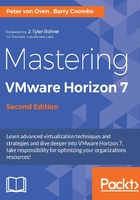
What this book covers
Chapter 1, Introduction to VDI and VMware Horizon 7, this chapter covers an introduction to VDI, explaining what it is, and how it compares with other VDI type technologies. We will then cover a brief history of the VMware VDI story, followed by an overview of the latest solution.
Chapter 2, An Overview of Horizon View Architecture and Components, will introduce you to the architectural components that make up the core VMware Horizon solution, concentrating on the virtual desktop elements of Horizon View Standard and the functionality of brokering virtual desktop machines.
Chapter 3, Design and Deployment Considerations, will introduce you to design and deployment techniques to take into consideration when undertaking your VMware Horizon project. We will discuss techniques to prove the technology and understanding how it will work inside your business, methods to assess your user's existing workload and how to use this information to help design your VMware Horizon Solution.
Chapter 4, Installing and Configuring Horizon View, will cover the installation process of the core Horizon View components, such as the Connection Server, Security Server, Replica Server, Enrollment Server, as well as the Cloud Pod Architecture feature. Following the installation, we will start to configure the base elements of a Horizon View installation.
Chapter 5, Securing Horizon View with SSL Certificates and True SSO, covers the aspect of VMware Horizon View, and in particular, how we deliver secure communication to the end user client, and also the different infrastructure components within the data center. The first half of this chapter will start with an overview of what an SSL certificate is, and then how to create and issue a certificate before configuring Horizon View to use it. In the second half of the chapter we will look at configuring the VMware True SSO feature.
Chapter 6, Building and Optimizing the Virtual Desktop OS, covers how to create and configure the virtual desktop machines after building the Horizon View infrastructure and its components, and then build the desktop operating system on them, configuring it so that it is running at its optimum performance level to run in a virtual environment.
Chapter 7, Managing and Configuring Desktop Pools, covers how Horizon View uses the concept of desktop pools to create a collection of virtual desktop machines for specific use cases, which in turn are allocated to the end users. In this chapter, we will look at the process to configure the different types of desktop pools.
Chapter 8, Delivering Remote Applications with View Hosted Apps, dives deeper into the key feature of Horizon Advanced Edition, and looks at how Horizon View publishes an application directly into the Horizon View Client, without the need of having to launch a full virtual desktop machine. We will walk through the installation and configuration process to get our first set of Horizon View published applications available to the end users.
Chapter 9, Delivering Session-Based Desktops with Horizon View, covers the other half of View's remoting capabilities and looks at how Horizon View can deliver session-based desktops from a Microsoft RDSH infrastructure.
Chapter 10, Horizon View Client Options, covers how the View Client is used to receive and display the virtual desktops and applications on the end user's device. In this chapter, we will look at the options for the View Client, both hardware and software, and discuss the various options and why you would choose one method over another.
Chapter 11, Upgrading to a New Version of Horizon View, covers all the things you need to consider before upgrading and will then take you through the upgrade process. This chapter is designed for those that are currently running a previous version of Horizon View and are looking to upgrade to the latest version.
Chapter 12, Troubleshooting Tips, covers some troubleshooting techniques and methods for use within Horizon View rather than going through a list of problems and issues.
Online Chapter, Fine-Tuning the End-User Experience, available at https://www.packtpub.com/sites/default/files/downloads/5657_FineTuningtheEndUserExperience.pdf, covers one of the key tasks in building the best user experience possible, which is to start fine-tuning the performance and experience for the end user's session with their virtual desktop machine. In this chapter, we will look at the tuning techniques and the pre-built Group Policy objects that can be applied to create that experience.
Online Chapter, Managing User Environments in Virtual Desktop Infrastructure, available at https://www.packtpub.com/sites/default/files/downloads/5657_ManagingUserEnvironmentsinVirtualDesktopInfrastructure.pdf, introduces you to Horizon View Persona Management, what it is, and why you would want to deploy it. We will then examine how it is driven by Standard Active Directory Group Policy finishing with an in depth look at the policies available. The second part of this chapter introduces you to VMware UEM and how to get up and running.